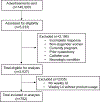The burdens of incontinence: Quantifying incontinence product usage and costs in women
- PMID: 35842824
- PMCID: PMC9446703
- DOI: 10.1002/nau.25007
The burdens of incontinence: Quantifying incontinence product usage and costs in women
Abstract
Introduction: Urinary incontinence is a common condition in women, who often use incontinence containment products to self-manage. Few studies have sought to quantify use and costs of incontinence products associated with subtypes of incontinence and severity, therefore this study aimed to quantify incontinence product use and personal costs to women.
Methods: This is a secondary analysis from a sample of adult women recruited electronically via ResearchMatch for a study on urinary symptoms and social determinants of health. Participants completed validated questionnaires on urinary symptoms, and were asked about daily numbers and types of incontinence products used and weekly costs, along with demographic and baseline clinical information, and information about unmet social needs. Descriptive statistics were performed, in addition to Wilcoxon rank sum and Kruskal-Wallis tests to compare incontinence product usage and cost based on type of incontinence, symptom severity, and other demographics, in addition to multivariable linear regression.
Results: A total of 702 women who reported using weekly incontinence products were included in the final analytic sample. Overall, women reported using a mean of 1.8 ± 2.1 incontinence products in 24 h (median: 1, interquartile range [IQR]: 1), with a maximum of 32. Mean weekly cost of was $5.42 ± $8.59 (median: $3, IQR: $4), with cost up to $100. Nonwhite women trended towards having higher product usage and cost, with significant cost increase seen among non-Hispanic Black women and Hispanic women. Usage and cost were higher in women who had less education, had household income below the poverty line, were on disability, were using Medicaid or were uninsured, had more unmet social needs, and in those with mixed incontinence. Additionally, daily product use and weekly costs increased with incontinence symptom severity, with the biggest increase between those with severe and very severe symptoms.
Conclusions: In this study, we were able to quantify the number of incontinence products used daily and the weekly costs in incontinent women across types and severity of incontinence. Costs were even greater and may be prohibitive, in women with more unmet social needs, Medicaid or no insurance, less than a college education, lower income, or on disability.
Keywords: cost; disparities; incontinence; leakage; pad usage; social needs.
© 2022 Wiley Periodicals LLC.
Conflict of interest statement
Conflict of Interests/Other disclosures
All authors declare that they have no conflicts of interests or disclosures.
Figures
References
Publication types
MeSH terms
Grants and funding
LinkOut - more resources
Full Text Sources
Medical



